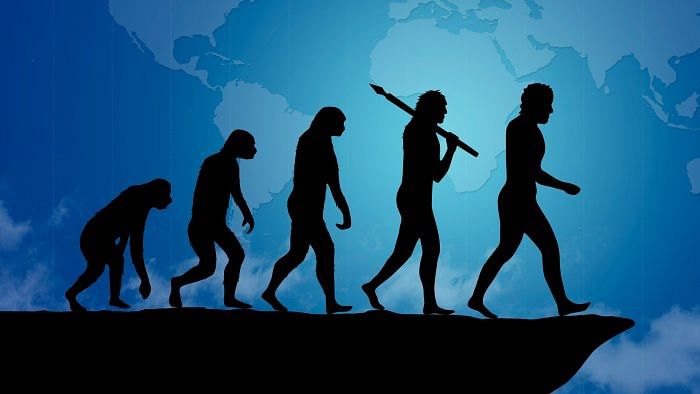
Humans and other mammals are said to have shared the same ancestor some 80 million years ago. Can the genetic trail help chart how we changed along the way? Or, closer home, how close are we to our nearest relatives, the chimpanzees, or even the earliest, but extinct, humans, or hominids, like the Neanderthals or the Denisovans? And what are the differences that helped humans thrive, while others perished?
We can now fully map the genome of humans, chimpanzees, or even bugs and microbes. But we cannot do that with extinct species because we have no living tissue. The information must come from DNA traces that we find in scraps of fossilised remains. The material samples are minuscule, and contaminated, over time and in handling.
The scarcity of DNA can be dealt with by amplifying what is available, using a method that became well known during the Covid-19 crisis—the technique of polymerase chain reaction (PCR), where bits of DNA are made to join or polymerise, repeatedly, in chain reactions, over cycles.
The first time DNA of an extinct creature was recovered was in 1984, from a museum specimen of the quagga, a zebra-like animal last seen a century earlier. A few years later, with PCR, we could recover DNA from bits of 7,000-year-old, soft human brain tissue, found in peat bogs in Florida. PCR is a powerful tool, which makes it possible to work with minimal traces, even of bones or teeth. As for contamination, new methods, like multiple trials and statistical analyses, have made it possible to sequence the DNA of a 30,000 to 1,00,000-year-old hominid.
And with still more improvements, a draft sequence of the genome of a 38,000-year-old Neanderthal human was published in 2010. The Neanderthal is an extinct sub-species first identified in 1856, from bones discovered in a limestone cave in Neanderthal, a small valley in western Germany. The bones were recognised straightaway as different from those of modern humans, but it was half a century before the Neanderthals were considered a legitimate species.
Pääbo’s method
Another strain of early human forerunners was the Denisovans, named after the Siberian Denisova cave, where the remains were found. The bones were of a young female and, in 2010, DNA was extracted from just a finger bone, using the methods that have been recognised in this year’s Nobel Prize.
“Neanderthals and Denisovans, so-called “archaic” humans, shared an ancestral population with the ancestors of modern humans about half a million years ago,” says a paper in the journal Science Advances, authored by Dr Svante Pääbo and his associates. The diagram shows this point at ‘A’, where modern humans are separated. And, as parts of the DNA of the Neanderthals and Denisovans have been accurately sequenced, it is possible to “identify the changes that characterise modern humans, the paper says.
Genetic change occurs through changes in the DNA. The DNA consists of millions of units, each building up as a sequence of just four building blocks. An accidental change in any one of them would alter the DNA and the way the organism functions.
We share most of our DNA with most other living things. But it is where there are differences that we have branched out. And with our knowledge of the genome of the Neanderthals and Denisovans, which form the last stretch leading to humans, we have found about a hundred instances, where there has been a change in one building block of the DNA of most humans, but not in the known DNA portions of Neanderthals and Denisovans. These may be the markers of genetic parting, but was the parting final?
While Neanderthals and Denisovans arose in Europe and Asia, the genetic line that has come down as humans originated in Africa and became dominant. When the line left Africa and encountered Neanderthals, the paper says, there was interbreeding and some Neanderthal DNA variants were introduced into the human gene pool. The paper says that these markers of contact with Neanderthals can be detected to this day.
Irritable bowel syndrome
A challenge faced by oxygen-dependent organisms, like mammals, is to overcome cell damage by a reactive form of oxygen. Animals down the evolutionary chain have managed it with the help of the anti-oxidant, glutathione. Glutathione consumes reactive oxygen, which saves important cell components. And then, it is recycled, with the help of an enzyme, glutathione reductase, or GR.
The paper says that among the 100-odd genetic differences between humans and Neanderthals is the one that affects the form of GR. The variant in most humans has glycine, an amino acid which is one of the four building blocks, in the sequence that codes for GR. But the Neanderthals have serine in place of glycine. As a result of the gene flow from Neanderthals to humans, the Neanderthal form, or the ancestral form, of GR is found in a small proportion of humans, 1–2% in the Indian subcontinent and much less in Europe.
Analysis shows, the authors say, that the ancestral form of GR is associated with disease of the circulatory system and with irritable bowel syndrome, or IBD. Both conditions are associated with oxidative stress–overproduction of reactive oxygen causes inflammation of blood vessel membrane and reduced availability of glutathione is a characteristic of IBD. And, GR is found in many parts of the body and oxidative stress is the reason for other diseases too. The modern human form of GR may hence play a protective role in more areas than the two that have been identified.
The paper says it is possible that this difference in the form of GR gave humans an advantage, which enabled them to dominate, while the so-called archaic humans went extinct.
(The author is the founder of simplescience.in)